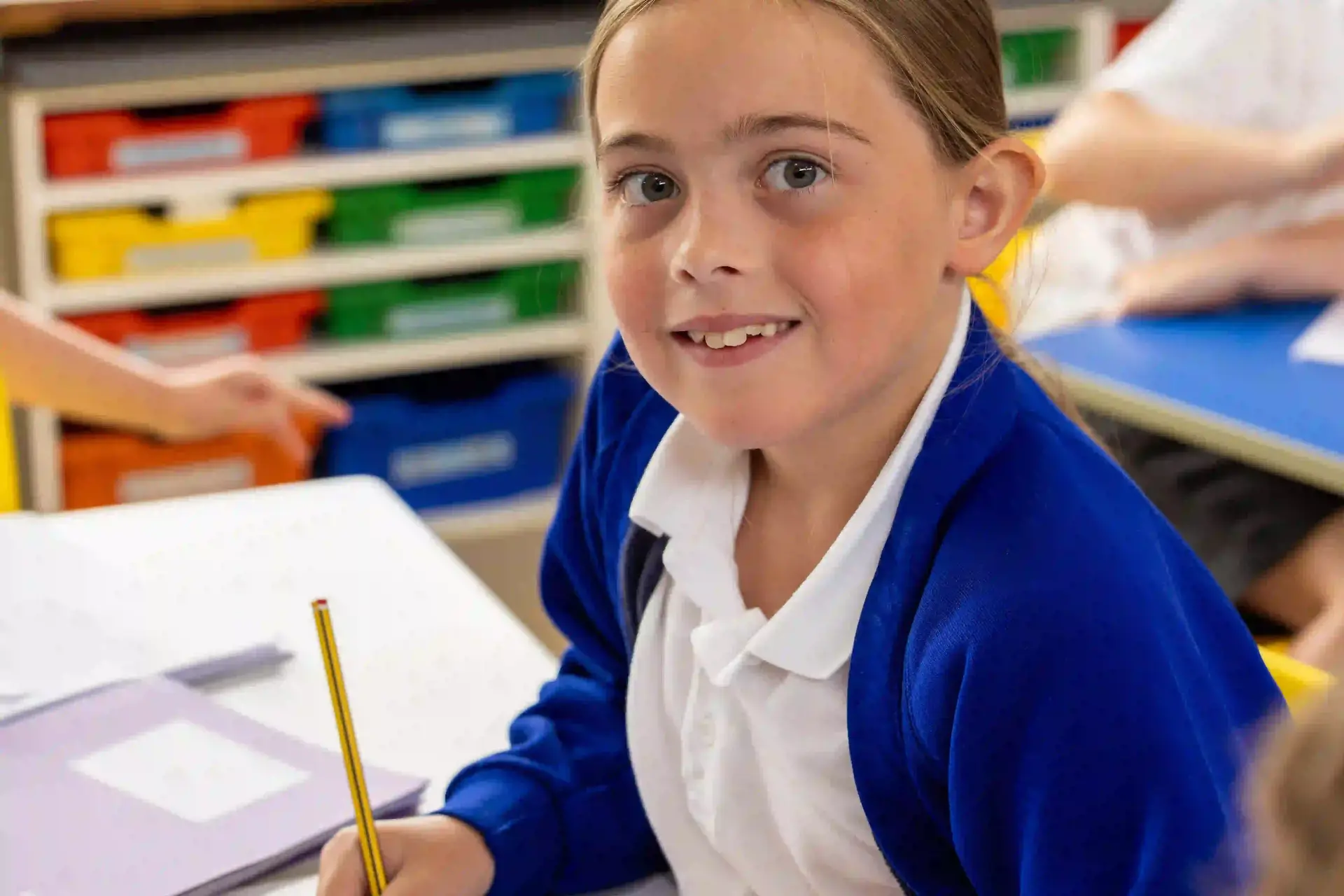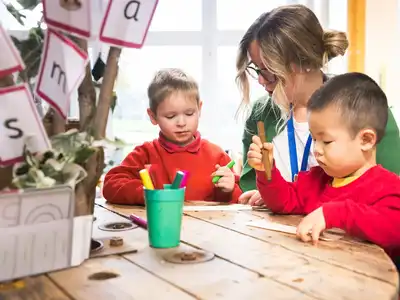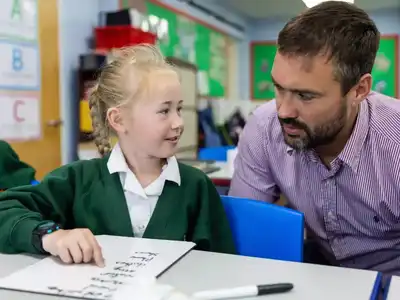Handwriting is often the first hurdle for pupils who are learning to write, and it can impact on their confidence and enjoyment of writing.
This article explores why handwriting matters, how it supports writing fluency, and what you can do to help pupils build strong foundations. You will find practical advice on teaching handwriting, supporting physical development, and making practice part of every day.
Why fluent handwriting matters
The Department for Education’s writing framework highlights that handwriting is a central part of transcription – the practical skills needed to get ideas onto the page. Research shows that handwriting text is beneficial for learning, as it influences how we encode information and supports memory (Ose Askvik, 2020). It also impacts conceptual understanding (Horbury, 2021). When pupils develop fluent handwriting, writing becomes less stressful and much more enjoyable, helping them grow into confident writers (Graham et al., 2012).
When handwriting is a struggle, it can affect pupils in several ways:
- It takes up brainpower: When handwriting isn’t fluent, pupils use up valuable effort forming each letter. This leaves them with less headspace for planning, editing and focusing on what they want to communicate (McCutchen, 1995; Education Endowment Foundation, 2021).
- It knocks motivation: Awkward or slow writing can make the process frustrating, leading pupils to avoid it (Graham et al., 2012).
- It affects how work is seen: Hard-to-read handwriting can distract from the content and lower marks, simply because ideas aren’t clear (Graham, Harris & Hebert, 2011).
Handwriting is a skill that underpins all written communication. By teaching it clearly, practising it regularly and supporting physical development, you help pupils write with confidence and fluency.
Support physical development for handwriting
It is easy to overlook the physical side of writing, but gross motor skills are the bedrock for success (Department for Education, 2023; Ofsted, 2024).
Before pupils can focus on spelling, punctuation or organising their ideas, they need to master the basics – sitting up straight, keeping their wrist steady and moving their fingers with control (Ofsted, 2024). Without these foundations, writing can feel like hard work, leading to sore hands, lost concentration and frustration if their efforts don’t look the way they want (Ofsted, 2024; Dinehart, 2015). Supporting gross and fine motor development gives every pupil the confidence and ability to write well (DfE, 2023).
To help your pupils build the physical skills they need for writing, you can take a few simple but important steps:
- Include plenty of activities that build both gross and fine motor skills. Things like threading beads, cutting paper, building with blocks, or playing with playdough all strengthen the muscles needed for writing (DfE, 2023).
- Teach pupils how to hold their pencil and sit correctly from the very start, and keep these routines consistent as they progress (Ofsted, 2024; DfE, 2021). Good posture and a relaxed grip make writing easier and help prevent tired hands (Erhardt, 2005; Dinehart, 2015), so it’s important that everyone knows what ‘ready to write’ looks like.
- Have adaptive equipment, like pencil grips or adjustable chairs, on hand for pupils who need a bit of extra support (Ofsted, 2024).
It's worth making sure every child knows how to hold a pencil comfortably. Most children start out with a fist grip, then move to a basic tripod grip, and finally master a dynamic tripod grip as their hand muscles get stronger (Schneck & Henderson, 1990).
Reflection prompts:
- How does your school’s curriculum and daily routines support pupils’ gross and fine motor development for writing?
- How do you spot pupils who struggle with grip, posture or physical co-ordination when writing?
- Is adaptive equipment – like pencil grips or adjustable chairs – readily available for pupils who need extra support?
Action steps:
- Give pupils time to stretch and move during the day, especially if they have been sitting and writing for a while.
- Make time for regular movement activities, such as climbing, jumping or outdoor games. These build core strength and balance, supporting good posture and control for writing.

Sequence the teaching of handwriting
Handwriting isn’t just about getting letters on the page – it’s a skill that brings together movement, vision and thinking, and it can be surprisingly tricky (Rosenblum, 2003). As children get better at it, you will notice them moving through a few clear stages: first, they start with mark making, then learn to form letters, put letters together into words, and eventually write in fluent, joined-up handwriting.
When you are teaching handwriting, break it down into three simple steps:
- Letter formation: Show pupils the right way to move their pencil for each letter. Group letters with similar shapes together – like a, c and o. Some letters, such as i, j, a, d, g, r, n, m and h, might need a bit more practice and feedback (EEF, 2020).
- Handwriting of individual letters: Once children can form letters correctly, give them lots of practice to help them write faster and more confidently. You want them to be able to write each letter without thinking about it (Graham et al., 2005).
- Joined handwriting: When children can write all 26 letters neatly and easily, you can start teaching joined-up writing. Show them the horizontal and diagonal joins between letters (DfE, 2021). Mixing cursive and printed letters can help keep things clear and readable (Graham & Weintraub, 1998; Quigley, 2022).
Make sure you teach these steps in order and give pupils examples of correctly spelled words to copy (EEF, 2020). Start with printed handwriting before moving on to cursive (Ofsted, 2022). As pupils get more accurate and faster, you will see their writing become longer, clearer and more confident (Graham et al., 2005).
Reflection prompt:
- How does your school approach handwriting instruction across different year groups and subject?
- In what ways do pupils know what is expected of them for handwriting in all areas of the curriculum?
- How do you currently identify pupils who struggle with handwriting?
Action steps:
- Look at where and how handwriting is taught across year groups. Consider whether there is a clear progression from mark making and pencil grip through to fluent, joined handwriting. Reflect on whether your curriculum allow pupils enough time to revisit and refine skills as they grow.
- Review whether all staff are following the same agreed approach to teaching handwriting, including routines for posture, grip and modelling.
Make handwriting practice part of every day
If you get children practising handwriting regularly – from Reception right through primary school – you are giving them a great start for confident, fluent writing (DfE, 2014; Ofsted, 2024). It is not enough to teach handwriting once and move on. Your pupils will make real progress when you keep giving them chances to practise and build on their skills as they grow (EEF, 2021).
Here is what works well:
- Break handwriting into small steps: Handwriting can be tricky, so break it down. Start with simple patterns and shapes, then move on to individual letters, and finally joining letters to make words and eventually apply these to full sentences (López-Escribano, 2022). Short, focused practice sessions let your pupils concentrate on one thing at a time, building their confidence and accuracy. Keep revisiting these skills, especially for those who need a bit more support, so everyone can keep making progress (Ofsted, 2024; EEF, 2021).
- Model good handwriting in every subject: Your pupils learn a lot by watching you. If you always use clear, neat handwriting – whether you are teaching maths, science or English – they will see that it matters everywhere, not just in handwriting lessons (DfE, 2014; Ofsted, 2024).
By weaving these routines into everyday lessons and across the curriculum, you will help your pupils develop handwriting fluency that lasts. They will be able to focus on the creative and communicative side of writing, boosting their confidence and helping them share their ideas clearly.
Take a cohesive approach to handwriting and phonics
Phonics teaching gives you a practical way to connect handwriting and spelling. When you help pupils form letters while saying their sounds, you reinforce both skills at the same time and show how spoken language links to written words (DfE, 2023; Fries, 1962). However, you still need to give dedicated practice to handwriting and spelling (Ofsted, 2024; EEF, 2021).
You might group letters by their movements in handwriting lessons, while in phonics you introduce them based on their sounds (DfE, 2023; Ofsted, 2024). Both approaches work well, as long as you teach each skill clearly and consistently (DfE, 2023; Ofsted, 2024). By making time for regular practice in all three areas, you help pupils build a solid foundation for writing and gain the confidence to use their skills independently.
Reflection prompts:
- How do handwriting and spelling lessons connect with your phonics programme in practice?
- In what ways do pupils practise handwriting and spelling skills across different contexts and subjects?
Action steps:
- Keep phonics and handwriting routines consistent, making sure pupils know what to expect in each lesson, using clear steps and regular practice to avoid confusion.
- Look out for pupils who need extra help with certain letters, sounds or spelling rules, and go back over tricky areas as needed.
This explainer is part of a series for teachers and school leaders on how to navigate the writing framework. Explore the other articles.
References
- Breadmore, H. L. (2019). Literacy development: evidence review.
- Department for Education (2014). ‘National curriculum in England: English programmes of study’.
- DfE. (2021). The National Curriculum.
- Dinehart, L. H. (2015). ‘Handwriting in early childhood education: Current research and future implications’. Journal of Early Childhood Literacy, 15(1), pp. 97-118.
- Education Endowment Foundation (2021). ‘Improving Literacy in Key Stage 1’.
- EEF. (2017). Improving Literacy in Key Stage 2.
- EEF. (2018). Preparing for Literacy: Improving Communication, Language and Literacy in the Early Years.
- EEF. (2019). Improving Literacy in Secondary Schools.
- EEF. (2020). Improving Literacy in Key Stage 1. Guidance Report.
- EEF. (2021). Improving Literacy in Key Stage 2. Guidance Report.
- Graham, S. a. (2005). Improving the writing performance of young struggling writers: Theoretical and programmatic research from the Center on Accelerating Student Learning. Journal of Special Education, 39 (1), 19–33.
- Graham, S., Harris, K. R., and Hebert, M. (2011). ‘It is more than just the message: Analysis of presentation effects in scoring writing’ Focus on Exceptional Children, 44(4), pp. 1-12.
- Graham, S., McKeown, D., Kiuhara, S., and Harris, K. R. (2012). ‘A meta-analysis of writing instruction for students in the elementary grades’ Journal of Educational Psychology, 104(4), pp. 879-896.
- Graham, S. W. (1998). The Relationship Between Handwriting Style and Speed and Legibility. The Journal of Educational Research, 91(5), 290–297.
- Horbury, S. R., & Edmonds, C. J. (2020). Taking Class Notes by Hand Compared to Typing: Effects on Children’s Recall and Understanding. Journal of Research in Childhood Education, 35(1), 55–67.
- Longcamp, M. Z.-P. (2005). The influence of writing practice on letter recognition in preschool children: A comparison between handwriting and typing. Acta psychologica, 119(1), 67-79.
- López-Escribano C, Martín-Babarro J, Pérez-López R. Promoting Handwriting Fluency for Preschool and Elementary-Age Students: Meta-Analysis and Meta-Synthesis of Research From 2000 to 2020. Front Psychol. 2022 May 26;13:841573.
- McCutchen, D. (1995). ‘Cognitive processes in children's writing: Developmental and individual differences’ Issues in Education: Contributions from Educational Psychology, 1, pp. 123-160.
- Ofsted (2024). ‘Telling the story: the English education subject report’.
- Ofsted. (2022). Research review series: English.
- Ose Askvik, E., Van der Weel, F. R., & Van der Meer, A. L. H. (2020). The importance of cursive handwriting over typewriting for learning in the classroom. Frontiers in Psychology, 11, Article 1810.
- Quigley, A. (2022). Closing the Writing Gap. Routledge.
- Rosenblum, S., Weiss, P. L., & Parush, S. (2003). Product and process evaluation of handwriting difficulties. Educational Psychology Review, 15(1), 41–81.
- Schneck CM, H. A. (1990). Descriptive analysis of the developmental progression of grip position for pencil and crayon control in nondysfunctional children. Am J Occup Ther. Oct;44(10):893-900.



